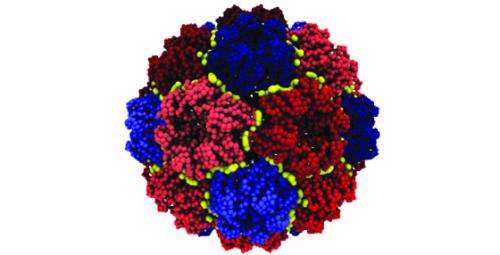Scientists explore the mechanisms of viruses' shells

The genome of viruses is usually enclosed inside a shell called capsid. Capsids have unique mechanic properties: they have to be resistant and at the same time capable of dissolving in order to release the genome into the infected cell. The scientists of the International School for Advanced Studies (SISSA) of Trieste have coordinated a study on the mechanic properties of viruses that have improved their understanding, so much that they were able to make conjectures on the behavior of still little-known viruses.
Viruses are like small vessels containing an active component, the genetic material, that can infect a host cell. The vessel, called capsid or vector, is basically a shell that changes its shape when it penetrates a cell to infect it, and may even break into pieces. The research team, that includes Guido Polles and Cristian Micheletti of SISSA, carried out computer simulations and used theoretical models to understand how such 'vessel' responds to thermal and mechanic stimulations. In such a way they identified the weak points of capsids and inferred their spontaneous assembly process.
Each shell is made of numerous protein 'tiles' that spontaneously join up like Lego pieces. A capsid may be composed of hundreds of such subunits, but each 'tile' consists of a limited number of proteins. The edges of the tiles are the "weak" lines where the deformation of the general structures takes place and along which the shell fragments if broken. Experimental observations have been carried out for some types of viruses to understand the internal dynamic of the vector (deformation) and the shape of the single tiles (which is usually rather regular - pentagons, hexagons, triangles). Micheletti and his colleagues produced a virtual model that, in principle, may be applied to any virus whose structure is known.
"Starting from the available information on the molecular structure of the capsid, we tried to 'tease' it a little to see the way it changed its shape. By simulating thermal fluctuations (to put it more simply, we virtually heated and then cooled it) observing along which lines the shell would modify. It is very likely that these very lines are also the spots in which the capsid will tend to break up." explained Polles and Micheletti. "Our model turned out to be very robust. The simulations, in fact, reproduced the same conditions observed in the experiments on known capsids. For this reason we have made other speculations on capsids on which we have no direct knowledge in this sense."
The research, carried out alongside with University of York (UK), Università di Torino and the Max Planck Institute of Mainz (Germany), was published in Plos Computational Biology. The studies on the nature of viral capsids are important to understand the mechanisms of virus infection (and to study methods to fight it).
Viral vectors, besides, are used in pharmacology and in gene therapy. The viruses' shells in fact may be employed as vectors to insert a therapy directly into cells, a cutting-edge methodology in today's medicine. Being able to identify the mechanically weak spots may be exploited, in perspective, to modify the natural capsids optimizing their resilience to convey and deliver the pharmacologic content more effectively.
More information: Guido Polles, G Indelicato, R Potestio, P Cermelli, R Twarock, C Micheletti, "Mechanical and Assembly Units of Viral Capsids Identified via Quasi-Rigid Domain Decomposition"November 14, PLOS Computational Biology 2013DOI: 10.1371/journal.pcbi.1003331
Journal information: PLoS Computational Biology
Provided by SISSA



















